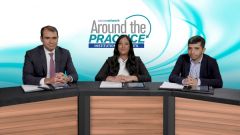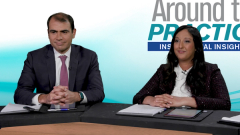
Patient Case 3: Cevostamab in a Patient with MM who Progressed on Multiple Lines of Therapy
Centering discussion on the final patient case, experts review the case of a patient with relapsed/refractory multiple myeloma managed with FcRH5-targeting bispecific cevostamab.
Episodes in this series

Transcript:
Ajai Chari, MD, PhD: Yes. It's an exciting time. And we've now covered BCMA and GPRC5D. But that's still not enough because there's yet another exciting target. And Krina, can you tell us about a patient who might've gotten an agent targeting this?
Krina K. Patel, MD, MSc: Yes. We're going to call it a non BCMA target bispecific for now. But this is a patient who is now 74 years old. A man with relapse refractory myeloma, was originally diagnosed in 2014 when he was 66 with R-ISS stage 2, IgG Lambda, had normal karyotype in FISH [fluorescence in situ hybridization]. And his CRAB criteria was 9.5. Creatinine was slightly elevated but nothing crazy, 1.3. And the rest of his labs, albumin is 3, protein - to a protein 11, he had the globulin gap. His IgG was 6,300. He had immuno precyst with the rest of his immunoglobulins already. And then, based on his light-chain ratio again of 0.1 fits the myeloma diagnosing criteria. And on imaging, didn't have lytic lesions, but at 66, man, shouldn't have generalized osteoporosis, but again, known to happen with myeloma. And then, bone marrow biopsy had 41% aberrant plasma cells. In terms of his treatment, initially, he's a patient of ours that's been almost full clinical trial. First line was induction with bortezomib lendex and panobinostat. And he ended up with a PR after 3 cycles. And then, unfortunately, started relapsing after his fourth cycle. Despite not having high risk cytogenetics or anything else where we wouldn't expect this, he was going back up. Then under a modified CVAD and stem cell mobilization followed by high dose melphalan, and then, he was on one of our clinical trials with NK cells cord blood NK cells and transplant on trial. And got a len maintenance. And he got len ixo maintenance also on trial. And unfortunately, despite all these things, he ended up having a PR with a nadir of N protein of 0.9. But still, with that PR, ended up doing well for four years and then ended up having a biochemical relapse with an M protein of 1.5. And then, started on dara pom dex. Achieved WGPR best response. And then, length for three and a half years later, he, again, had a biochemical progression and then we started on clinical trial with this non BCMA T-cell engager. And again, the base line M protein was 1.9. This is a patient that did not have prior BCMA therapy that went on. There's a step up dosing and did well, was admitted, the drug was given for 4 hours over IV. And as soon as this drug was done, he ended up with this rash on his lower legs and abdomen. It didn't cause symptoms but just had this rash suddenly. And about 7 hours after the infusion, he ended up with a fever of 38.3 and for us, we went ahead and set cultures to make sure he didn't have an infection. He was started on antibiotics initially just because the rash and everything else. They wanted to make sure he didn't have something hiding. Once everything was negative, we went ahead and stopped antibiotics. He ended up going home with, we called it, grade I CRS. Then he was admitted the next week for the full dose and didn't have CRS or another toxicity at this point. And then, what was interesting, at cycle 3, suddenly, his NC dropped. We repeated it to make sure it was real, his NC was 0. Something different between CAR-T and bispecifics here. Usually we don't expect neutropenia necessarily, but we went ahead and had all this treatment, here's CGCSF. And then, once he got the next dose, he ended up having fevers again. We went ahead and called it grade I CRS. But after that, overall did well for us because most of our patients have been exposed to CMV, we went ahead and tested them for CMV which was negative, which is great. And then cycle 6 day one started having worsening neuropathy had a baseline grade 1 went to grade 2 treatment was delayed neuropathy returned to grade one and then continued treatment so far.
In terms of, AE management, in terms of response, you know, again, you can see that he never really he had this like continued PR initially with his initial few years of treatment with DPD I guess you can say another immune based therapy, he had the best response that PGPR And then when he got this bispecific, this is just the first protein after and you can see you ended up with a PR.
Ajai Chari, MD, PhD: Thanks for that great case. Krina. It seems like another deep durable remission and a heavily treated patient whom we you know, things we've never seen before. Sham. Maybe we can hear a little bit about the mechanism of action of yet another target, bispecific FcRH5.
Sham Mailankody, MD: This is the third target for the bispecifics and T cell engaging therapies FcRH5 It's a B cell plasma cell marker of unclear physiologic function similar to GPRC five D incidentally, both we don't fully understand their physiological role. But FcRH5 is present in B cells and plasma cells, virtually all myeloma patients have some degree of PFC or h5 expression. It's also in one Q 21 chromosome. So those of you to treat myeloma familiar about 20 to 40% of our patients have gains or amplifications one Q 21. This is making it a good target for multiple myeloma and similar to other bispecifics on the other hand, it engages CD three which is present on T cells so CD three FcRH5 bispecifics are in development currently You're
Ajai Chari, MD, PhD: Great. And Krina, maybe you could tell us a little bit about the study cevostamab from last year's ASCO?
Krina K. Patel, MD, MSc: This was big, over 160 patients, mostly phase 1 to, again, heavily pretreated patients, 6 million lines of therapy and 21% of patients have extramedullary disease, and overall safe 80% of patients had CRS, but again, mostly grade 1, 2. And then 28% of these patients had prior BCMA. And again, response rates overall in the 50 to 60%. For patients who have multiple lines of therapy, we call them Penta exposed, and now BCMA exposed to still have these great response rates is pretty impressive.
Ajai Chari, MD, PhD: What are your thoughts, what's your reaction to this? And where do you think this agent belongs in myeloma armamentarium?
Alfred L. Garfall, MD, MS: Yes, it's amazing to have yet another target, a target I hadn't even heard of until, you know, just recent years and the study came online. And very exciting by all accounts, you know, sort of similar safety and efficacy profile to the other BCMA bispecifics into or the other bispecifics in terms of cytokine release syndrome, but very good tolerability with prolonged dosing. And it's very exciting.
Ajai Chari, MD, PhD: Yes, what's also unique about this from all the other bispecifics, there's, only one other one construct, but this one is a fixed duration. Most bispecifics are being given to progression. And this one's unique because it basically terminates after one year. And what's exciting, we'll be hearing it this year at the abstracts out, they looked at 16 patients who had discontinued therapy. And what's striking is that in the patients who had deep durable remission, so the CRS and stringency errs, no one relapsed at the last data cut, the patients who had less deep remissions like the prb GPR, we did see some evolution of the disease, which is not surprising, you know, name a study where people who do better don't do better, right. But I think what this calls into question, is this risk benefit calculus that we need to do, right? What are the benefits of treating to progression? And what are the risks, particularly when with those Infectious Risks that we've talked about? If you're going to keep getting those Infectious Risks that never plateaus? That calls for more fixed duration of therapy. Conversely, we must keep in mind that these are all still pretty early. And we are noticing that there are certain subgroups of patients that are not being optimally helped. And, I would call out extramedullary in ISS 3, I think, across the board. We see with bispecific and car-T’s those patients seem to be having worse outcomes. So I probably would be a little bit less excited about discontinuation of those patients until we have a better, you know, deep durable remission for those.
Transcript edited for clarity.
Newsletter
Stay up to date on recent advances in the multidisciplinary approach to cancer.





































































































